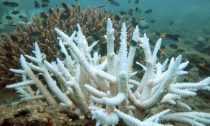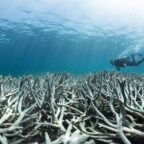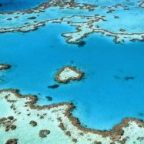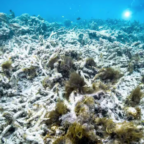
More than half of the spectacular and remote coral reefs beyond the boundaries of the Great Barrier Reef suffered severe bleaching this summer, an underwater scientific expedition has found. Several reefs in the vast Coral Sea marine park known among divers for their arrays of corals, large fish and precipitous drop offs into the deep ocean suffered extreme bleaching. Scientists from James Cook University’s ARC Centre of Excellence for Coral Reef Studies recorded the bleaching on the reefs that are more than 200km offshore during dives in February and March.
Some reefs had 90% of their shallow water corals bleached – an extreme level likely to lead to deaths of many corals, said Prof Andrew Hoey, a co-ordinator of the expedition.
Hoey said: “It’s becoming too familiar to jump in to the water and see large swatches of severely bleached corals. It’s quite devastating.”
Even at 10 metres deep, some reefs saw half their corals bleached, with isolated bleaching seen as deep as 20 metres.
Hoey, a marine biologist at James Cook University, said the results were preliminary with further analysis to be carried out for the three-year monitoring project, which comes to a close in June.
The project is the most extensive reef survey of the Coral Sea Marine Park ever undertaken and is funded by the federal government agency Parks Australia.
Hoey said in 2020 they had visited “the majority of the reef complexes” across the marine park that covers almost 1m sq km. A small number of reefs in the far north and far east were not visited this year.
More than half of the reefs visited had been severely bleached, including dive tourism spots like Osprey Reef north of Port Douglas, Bougainville Reef off Cooktown and Flinders Reef off Townsville.
The Coral Sea reefs are less well known than their neighbours to the west on the Great Barrier Reef, which experienced a third mass bleaching outbreak in five years this summer.
The Coral Sea reefs were surveyed between mid-February and mid-March. Hoey said water temperatures were above 30C. Usual temperatures were 27C and 28C.
Corals bleach when they sit in unusually hot water for too long. Corals can recover if bleaching is only mild but if temperatures are very high for prolonged periods, corals can die.
On 18 March, the US government’s Coral Reef Watch program produced analysis of heat stress over the Great Barrier Reef and the Coral Sea showing “significant amounts of heat stress”.
Townsville-based Dr William Skirving, of Coral Reef Watch, told Guardian Australia: “All the Australia reefs outside of the GBR will have had significant amounts of bleaching and many would have had significant amounts of mortality.”
Hoey said unlike reefs closer to shore in the Great Barrier Reef Marine Park, the reefs in the Coral Sea were largely unaffected by pollution and fishing pressures.
“But they are extremely susceptible to climate-induced stresses,” he said.
Hoey said it was “hard to predict” how many corals would die.
These more remote reefs, he said, relied on their own corals to spawn and regrow, unlike the more tightly packed reefs of the Great Barrier Reef.
He said: “Any coral mortality will take a lot longer to recover from because there is hundreds of kilometres between these reefs and so there’s unlikely to be a lot of connectivity between them.”
“Because of their isolation we have a lot to learn about these reefs, but we would still expect any fish and other organisms relying on the reefs to have been affected, particularly those relying on the corals for food and shelter.”
Richard Leck, WWF-Australia’s head of oceans, said it was concerning that Coral Sea reefs had bleached because they were regarded as more resilient, as they benefitted from cool water upwelling and very clear water.
He said: “The fact they have bleached shows how extreme the underwater heatwave was in the Coral Sea. It shows how close we are to a tipping point with climate change and coral reefs.
“The reefs in the Coral Sea are less well known, except amongst the high-end scuba diving community. They’re a jewel in the crown for many divers around the world to come and visit.”
Craig Stephen, managing director of Mike Ball Dive Expeditions, has been visiting the Coral Sea reefs since 1995.
He said there were still many amazing places to visit on the Great Barrier Reef and the Coral Sea and “given time” he said he thought the reefs would recover.
“These [Coral Sea] reefs rise from the sheer depths in very clear water,” he said. “Large soft corals and sea fans dominate the depths and sharks abound, giving the diver a real sense of being in the abyss.
“You can hang off a wall that’s 1,000 metres and there you feel pretty insignificant. People enjoy the vastness of it.”
The 2020 bleaching was a “reset point for many of us” he said, adding: “We do need to step back and have a look at what we are doing to the planet.
“If we don’t take a good look at ourselves and do something about our CO2 emissions then things will get out of our control. There is a chance to do something about this.”














Social Profiles